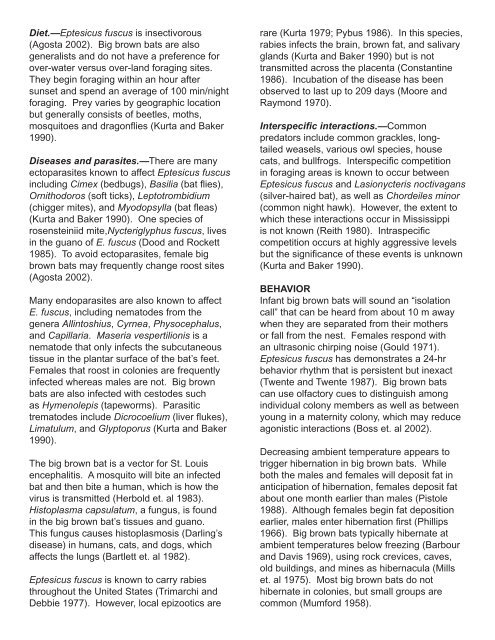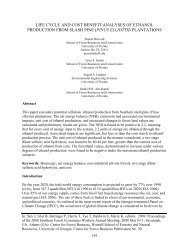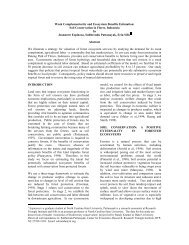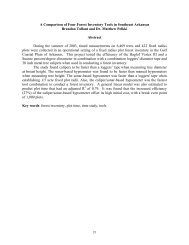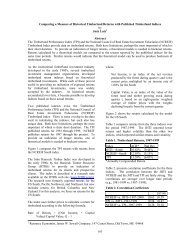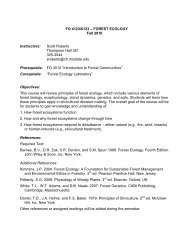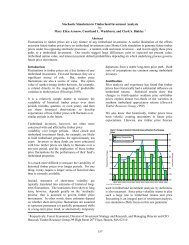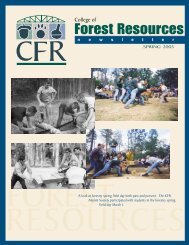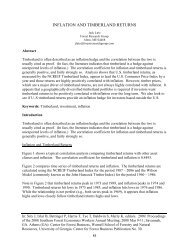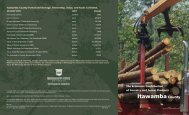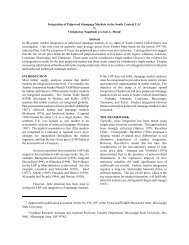Big Brown Bat Eptesicus fuscus (Beauvois, 1796) - College of Forest ...
Big Brown Bat Eptesicus fuscus (Beauvois, 1796) - College of Forest ...
Big Brown Bat Eptesicus fuscus (Beauvois, 1796) - College of Forest ...
Create successful ePaper yourself
Turn your PDF publications into a flip-book with our unique Google optimized e-Paper software.
Diet.—<strong>Eptesicus</strong> <strong>fuscus</strong> is insectivorous<br />
(Agosta 2002). <strong>Big</strong> brown bats are also<br />
generalists and do not have a preference for<br />
over-water versus over-land foraging sites.<br />
They begin foraging within an hour after<br />
sunset and spend an average <strong>of</strong> 100 min/night<br />
foraging. Prey varies by geographic location<br />
but generally consists <strong>of</strong> beetles, moths,<br />
mosquitoes and dragonfl ies (Kurta and Baker<br />
1990).<br />
Diseases and parasites.—There are many<br />
ectoparasites known to affect <strong>Eptesicus</strong> <strong>fuscus</strong><br />
including Cimex (bedbugs), Basilia (bat fl ies),<br />
Ornithodoros (s<strong>of</strong>t ticks), Leptotrombidium<br />
(chigger mites), and Myodopsylla (bat fl eas)<br />
(Kurta and Baker 1990). One species <strong>of</strong><br />
rosensteiniid mite,Nycteriglyphus <strong>fuscus</strong>, lives<br />
in the guano <strong>of</strong> E. <strong>fuscus</strong> (Dood and Rockett<br />
1985). To avoid ectoparasites, female big<br />
brown bats may frequently change roost sites<br />
(Agosta 2002).<br />
Many endoparasites are also known to affect<br />
E. <strong>fuscus</strong>, including nematodes from the<br />
genera Allintoshius, Cyrnea, Physocephalus,<br />
and Capillaria. Maseria vespertilionis is a<br />
nematode that only infects the subcutaneous<br />
tissue in the plantar surface <strong>of</strong> the bat’s feet.<br />
Females that roost in colonies are frequently<br />
infected whereas males are not. <strong>Big</strong> brown<br />
bats are also infected with cestodes such<br />
as Hymenolepis (tapeworms). Parasitic<br />
trematodes include Dicrocoelium (liver fl ukes),<br />
Limatulum, and Glyptoporus (Kurta and Baker<br />
1990).<br />
The big brown bat is a vector for St. Louis<br />
encephalitis. A mosquito will bite an infected<br />
bat and then bite a human, which is how the<br />
virus is transmitted (Herbold et. al 1983).<br />
Histoplasma capsulatum, a fungus, is found<br />
in the big brown bat’s tissues and guano.<br />
This fungus causes histoplasmosis (Darling’s<br />
disease) in humans, cats, and dogs, which<br />
affects the lungs (Bartlett et. al 1982).<br />
<strong>Eptesicus</strong> <strong>fuscus</strong> is known to carry rabies<br />
throughout the United States (Trimarchi and<br />
Debbie 1977). However, local epizootics are<br />
rare (Kurta 1979; Pybus 1986). In this species,<br />
rabies infects the brain, brown fat, and salivary<br />
glands (Kurta and Baker 1990) but is not<br />
transmitted across the placenta (Constantine<br />
1986). Incubation <strong>of</strong> the disease has been<br />
observed to last up to 209 days (Moore and<br />
Raymond 1970).<br />
Interspecific interactions.—Common<br />
predators include common grackles, longtailed<br />
weasels, various owl species, house<br />
cats, and bullfrogs. Interspecifi c competition<br />
in foraging areas is known to occur between<br />
<strong>Eptesicus</strong> <strong>fuscus</strong> and Lasionycteris noctivagans<br />
(silver-haired bat), as well as Chordeiles minor<br />
(common night hawk). However, the extent to<br />
which these interactions occur in Mississippi<br />
is not known (Reith 1980). Intraspecifi c<br />
competition occurs at highly aggressive levels<br />
but the signifi cance <strong>of</strong> these events is unknown<br />
(Kurta and Baker 1990).<br />
BEHAVIOR<br />
Infant big brown bats will sound an “isolation<br />
call” that can be heard from about 10 m away<br />
when they are separated from their mothers<br />
or fall from the nest. Females respond with<br />
an ultrasonic chirping noise (Gould 1971).<br />
<strong>Eptesicus</strong> <strong>fuscus</strong> has demonstrates a 24-hr<br />
behavior rhythm that is persistent but inexact<br />
(Twente and Twente 1987). <strong>Big</strong> brown bats<br />
can use olfactory cues to distinguish among<br />
individual colony members as well as between<br />
young in a maternity colony, which may reduce<br />
agonistic interactions (Boss et. al 2002).<br />
Decreasing ambient temperature appears to<br />
trigger hibernation in big brown bats. While<br />
both the males and females will deposit fat in<br />
anticipation <strong>of</strong> hibernation, females deposit fat<br />
about one month earlier than males (Pistole<br />
1988). Although females begin fat deposition<br />
earlier, males enter hibernation fi rst (Phillips<br />
1966). <strong>Big</strong> brown bats typically hibernate at<br />
ambient temperatures below freezing (Barbour<br />
and Davis 1969), using rock crevices, caves,<br />
old buildings, and mines as hibernacula (Mills<br />
et. al 1975). Most big brown bats do not<br />
hibernate in colonies, but small groups are<br />
common (Mumford 1958).


